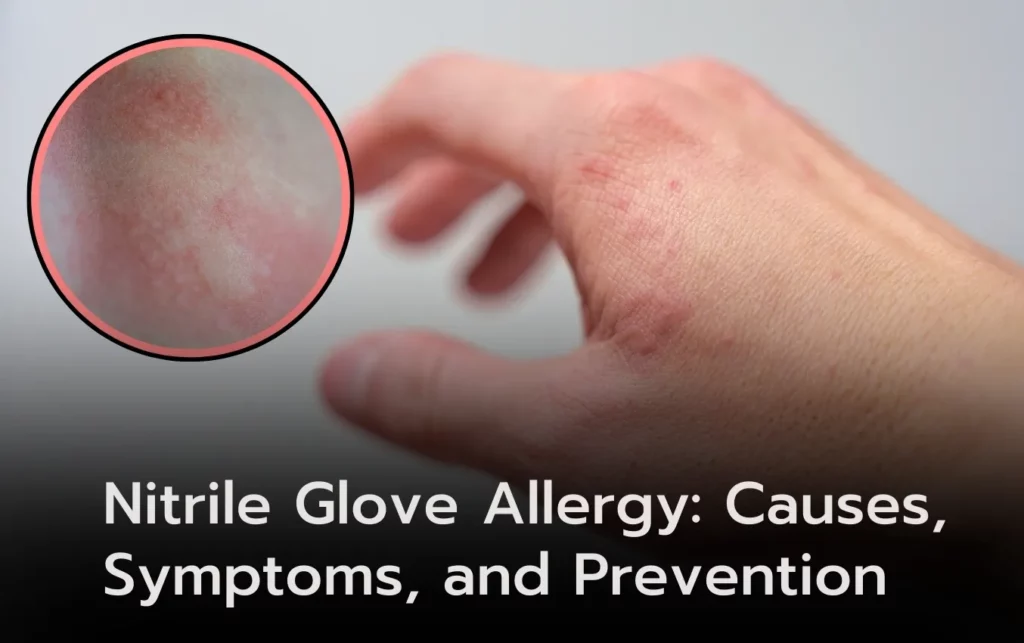Nitrile gloves, known for their safety and popularity, can surprisingly lead to allergic reactions in some individuals. This informative article explores into the causes, symptoms, and prevention of nitrile glove allergies. From exploring the manufacturing process of nitrile gloves to examining the allergens found in them, this comprehensive guide aims to help readers understand the complexities of nitrile allergies and provide insights on how to manage and prevent them effectively.
Table of Contents
- What is Nitrile Glove Allergy?
- Types of Nitrile Gloves Allergies
- How Do Nitrile Gloves Cause Allergies?
- Accelerator Material
- Dyes Used in Manufacturing
- What are the Allergens Found in Nitrile Gloves?
- Dyes
- Accelerators
- Symptoms of Nitrile Glove Allergy
- Hives
- Cracks
- Swelling
- Treatment of Nitrile Glove Allergy
- Pharmaceutical Options
- Home Remedies
- Prevention of Nitrile Glove Allergy
- Switching to Vinyl or Neoprene
- Accelerator-Free Gloves
- Hypoallergenic Gloves
- Regular Hand Washing
- Not All Gloves are Created Equal: Hypoallergenic Gloves vs. Accelerator-Free Gloves
- Frequently Asked Questions (FAQ)
What is Nitrile Glove Allergy?
The body’s immune response to nitrile, a synthetic rubber used in glove manufacturing, results in nitrile glove allergy. This allergic reaction can range from mild contact dermatitis to severe cases requiring immediate medical attention.
Types of Nitrile Gloves Allergies
- Chemical Accelerators Allergies
- Description: Some nitrile gloves are manufactured using chemical accelerators such as thiurams, carbamates, and mercaptobenzothiazole.
- Implications: Exposure to these chemicals can lead to allergic reactions in sensitive individuals. Symptoms may include redness, itching, and swelling.
- Resin Allergies
- Description: Certain nitrile gloves contain synthetic resins to improve durability and elasticity.
- Implications: Resin allergies are less common but can cause skin irritation and contact dermatitis.
- Powdered Nitrile Gloves Allergies
- Description: Powdered nitrile gloves use a cornstarch powder to make donning the gloves easier.
- Implications: In rare cases, the powder can cause respiratory and skin allergies, particularly in individuals with pre-existing respiratory conditions.
- Dye Allergies
- Description: Colored nitrile gloves are tinted using various dyes.
- Implications: Some people may develop allergic reactions to specific dyes, which may result in localized skin irritation.
- Proteins in Nitrile
- Description: Though nitrile gloves are synthetic, they can sometimes contain small amounts of proteins.
- Implications: Allergic reactions to these proteins are exceedingly rare but may cause skin reactions in highly sensitive individuals.
Table: Comparison of Latex and Nitrile Glove Allergies
| Allergy Type | Latex Gloves | Nitrile Gloves |
|---|---|---|
| Chemical Accelerators | Common | Common |
| Protein Allergies | High | Rare |
| Powder Allergies | Possible | Possible |
| Dye Allergies | Rare | Rare |
| General Irritation | Common | Less Common |
How Do Nitrile Gloves Cause Allergies?

Accelerator Material
The accelerator material used in the manufacturing process of nitrile gloves is one of the main reasons for allergies. Accelerators are sulfur-based materials that transform the glove material into a thin and elastic form. Thiurams, carbamates, and mercaptobenzothiazoles are common accelerators found in nitrile gloves.
Dyes Used in Manufacturing
One common allergen found in nitrile gloves is the dyes used in their manufacturing process. Studies have identified several types of dyes, such as Pigment Blue 15, Orange F2G, and Disperse Red 17, that can cause contact dermatitis in individuals sensitive to these substances.
It is crucial to inspect the ingredients used in the manufacture of nitrile gloves, as both accelerators and dyes can lead to allergic reactions in some individuals. By understanding the materials present in the gloves, users can take necessary precautions to prevent allergic responses.
What are the Allergens Found in Nitrile Gloves?
Dyes
Some types of dyes found in nitrile gloves can cause contact dermatitis. Colored nitrile gloves are common in various industries, including medicine for double gloving and color coding purposes. Studies have identified specific dyes like Pigment Blue 15 and Disperse Orange 3 as potential allergens that can trigger allergic reactions.
Accelerators
With the manufacturing process of nitrile gloves, accelerators are used to transform the material into a thin and elastic form. Thiurams, carbamates, and mercaptobenzothiazoles are the main accelerators known to cause allergies in nitrile gloves. For instance, thiurams contribute to more than 50% of nitrile glove allergies, with carbamates following closely behind.
Symptoms of Nitrile Glove Allergy
Hives
Symptoms of nitrile glove allergy can manifest as hives, presenting as red or white bumps that can be itchy and painful. These hives may appear and disappear, so careful monitoring is important. It is recommended to wash hands with soap after removing nitrile gloves to prevent further irritation.
Cracks
The development of irritated skin that can crack easily is another symptom of nitrile glove allergy. These cracks can lead to burns, stings, bleeding, and potentially infections. Seeking medical advice is crucial if these symptoms occur.
Plus, continued use of nitrile gloves after experiencing hives and cracks can lead to swelling. The skin may feel stretched and inflamed, signaling the need for immediate medical attention.
Swelling
For individuals with nitrile glove allergies, swelling may arise as a result of ongoing exposure to allergens. Seeking treatment and avoiding further contact with the gloves is important to prevent worsening symptoms.
For instance, other life-threatening symptoms like face or tongue swelling, difficulty breathing, and difficulty swallowing can indicate a severe allergic reaction that requires immediate medical assistance.
Treatment of Nitrile Glove Allergy
Pharmaceutical Options
Nitrile glove allergy can be treated with pharmaceutical options. Topical treatments such as 1% hydrocortisone cream or calamine lotion can help reduce itchiness and hives. For more severe cases, oral antihistamines like diphenhydramine or loratadine can be taken to alleviate symptoms. It is necessary to discontinue the use of nitrile gloves to prevent further irritation.
Home Remedies
On the other hand, if you prefer natural remedies, there are ways to soothe nitrile glove allergies at home. Cold compressions can reduce inflammation, while soaking hands in cool water can help calm irritated skin. It is crucial to avoid scratching the affected area and to moisturize with honey, oatmeal, or aloe vera-based products to promote skin healing.
Another effective home remedy is applying aloe vera gel directly to the affected skin. Aloe vera has anti-inflammatory and soothing properties that can help alleviate itchiness and reduce redness caused by nitrile glove allergy.
Prevention of Nitrile Glove Allergy
Switching to Vinyl or Neoprene
Allergic reactions to nitrile gloves can be avoided by switching to alternative materials such as vinyl or neoprene. These materials offer similar protective properties without the risk of causing allergic reactions.
Accelerator-Free Gloves
With the introduction of accelerator-free nitrile gloves, individuals with nitrile allergies have a safer option for hand protection. These gloves are designed to provide the necessary flexibility and comfort without the presence of allergens.
Nitrile allergies are primarily caused by accelerators used in the glove manufacturing process. Accelerator-free nitrile gloves eliminate this risk, making them a suitable choice for those prone to allergic reactions.
Hypoallergenic Gloves
For individuals sensitive to allergens, hypoallergenic gloves are an ideal choice. These gloves are manufactured with low-allergen concentrations or in allergen-free processes, reducing the risk of allergic reactions.
The allergen-free or low-allergen composition of hypoallergenic gloves makes them a safe and practical option for various industries, including healthcare and manufacturing.
Regular Hand Washing
On a daily basis, regular hand washing before donning and after doffing nitrile gloves is a simple yet effective preventive measure against nitrile glove allergies. This practice helps remove any potential irritants and maintains hand hygiene, reducing the likelihood of allergic reactions.
Prevention of nitrile glove allergies involves adopting proactive measures such as utilizing alternative glove materials, selecting accelerator-free or hypoallergenic options, and maintaining proper hand hygiene through regular washing.
Not All Gloves are Created Equal: Hypoallergenic Gloves vs. Accelerator-Free Gloves
Not all gloves are created equal. As far as protecting your hands while avoiding allergic reactions, it’s imperative to understand the differences between hypoallergenic gloves and accelerator-free gloves. Let’s probe the details.
Hypoallergenic gloves are an umbrella term that includes various types of gloves, including accelerator-free gloves. Accelerators, which are often used in the manufacturing process of nitrile gloves, can cause contact dermatitis. This can lead to irritation and work delays. As a response to this issue, newer technologies have paved the way for accelerator-free nitrile gloves. These gloves offer a snug and comfortable fit, though the strength may be slightly compromised compared to traditional nitrile gloves.
On the other hand, hypoallergenic nitrile gloves are manufactured with a focus on being low-allergen or allergen-free. These gloves can be latex-free, accelerator-free, and powder-free, making them safe for use in various industries, including medical and industrial settings.
Both hypoallergenic gloves and accelerator-free gloves provide viable alternatives for individuals who suffer from nitrile glove allergies. If you find yourself facing allergic reactions to nitrile gloves, exploring these options may be a suitable path forward to ensure the safety and comfort of your hands.
Following this comprehensive discussion on nitrile glove allergies, it is evident that while nitrile gloves are a popular choice for protection, they can still cause allergic reactions in some individuals. Understanding the causes, symptoms, and prevention methods of nitrile glove allergies is crucial to ensure the safety and well-being of glove users. By being aware of the allergens found in nitrile gloves, utilizing proper treatment methods, and considering alternative glove options, individuals can effectively navigate and manage nitrile glove allergies.
Frequently Asked Questions (FAQ)
Is nitrile a natural product?
No, nitrile is a synthetic product. It is the product of the polymerization of acrylonitrile and butadiene.
Can nitrile gloves cause allergy?
Yes, nitrile gloves can lead to an allergic reaction in rare cases.
What’s the difference between a skin rash and an allergy?
A skin rash can be due to a mild reaction to the powder in the gloves. You can also be having a response to your sweat. On the other hand, an allergy is more severe and can lead to hives and blisters.
What causes nitrile glove allergy?
The dyes and the accelerator used in manufacturing nitrile gloves cause this allergy. Therefore, nitrile is a non-allergic material.
Is nitrile allergy treatable?
Yes, nitrile glove allergy can be treated by taking some medication. You can also apply cold compressions to the affected area if your allergy is mild.
Can I use lotions to treat my nitrile glove allergy?
Yes, you can use honey-based, oatmeal-based, or aloe-based lotions.
What do you recommend if I am allergic to nitrile gloves?
You might consider trying accelerator-free gloves or hypoallergenic gloves.
What are the most appealing properties of nitrile gloves?
Nitrile gloves have high puncture resistance, chemical resistance, and tear resistance. They are also sold in different colors, allowing for double gloving and color coding.
